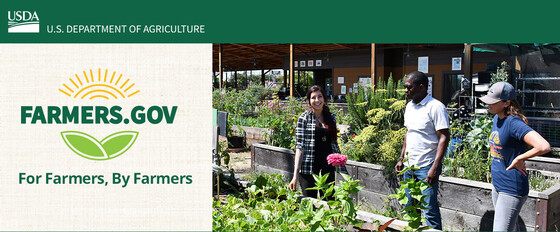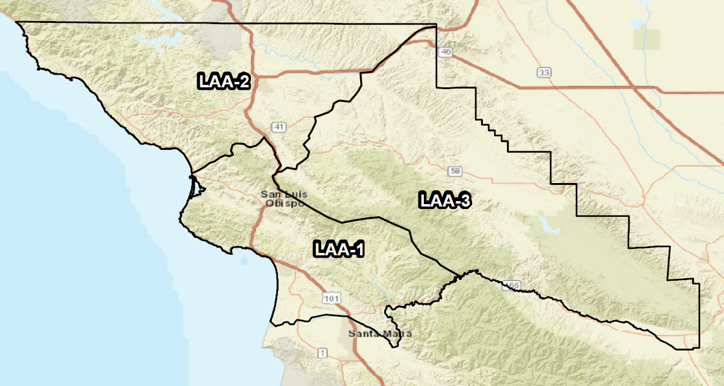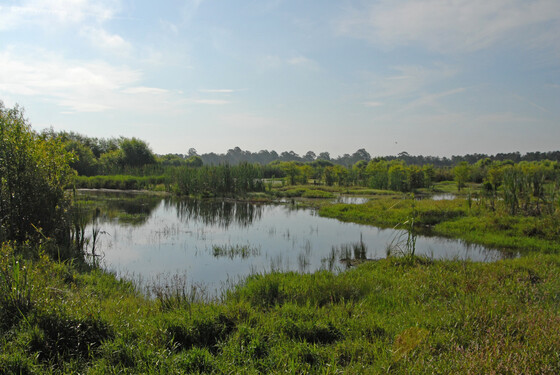 USDA applicants can set up a Farmers.gov account to review updates, complete online forms, and review FSA maps. Click on the photo to set up your account.
- Crop Reporting Deadlines
- July 15 - Spring Alfalfa Seed, Spring Oats (Planted 04/21 - 05/31), Perennial Forage (Native Grass), Potatoes (Planted 03/16 - 06/30), Sugar Beets (Planted 05/01 - 06/30), Wheat (Planted 03/06 - 05/31), CRP, and All Other Crops (Native Grass)
- Emergency Relief Program Phase 2 - July 14, 2023
- Pandemic Assistance Revenue Program - July 14, 2023
- County Committee Nominations - August 1, 2023
- Emergency Conservation Program - October 13, 2023
 The U.S. Department of Agriculture (USDA) Farm Service Agency (FSA) encourages all farmers, ranchers, and FSA program participants to take part in the San Luis Obispo County Committee election nomination process.
FSA’s county committees are a critical component of the day-to-day operations of FSA and allow grassroots input and local administration of federal farm programs.
Committees are comprised of locally elected agricultural producers responsible for the fair and equitable administration of FSA farm programs in their counties. Committee members are accountable to the Secretary of Agriculture. If elected, members become part of a local decision making and farm program delivery process.
Local Administrative Area (LAA) 3 is up for reelection, meaning producers who reside in the Eastern part of San Luis Obispo County may be eligible to run and serve on the County Committee. Please see the photo above to see if your farm or ranch is within LAA 3. To request a nomination form, visit this link: fsa.usda.gov/elections or call the office at (805) 434-0396, ext. 2.
Click on the photo to get a County Committee Nomination Form!
U.S. Department of Agriculture (USDA) Farm Service Agency (FSA) Acting County Executive Director Russell Todd in San Luis Obispo County reminds farmers and landowners that FSA is hosting an informational meeting regarding the 2023 County Committee Election process on July 6, 2023, at 2:00 PM. at the USDA Service Center located at 65 South Main St. Suite 106, Templeton, CA 93465. Producers, including minority, women and new farmers, are encouraged to attend the meeting and participate in the 2023 election.
The county committee nomination period began on June 15, 2023. Nomination forms must be postmarked or received in the San Luis Obispo County FSA office by close of business on Aug. 1, 2023.
For election purposes, counties are divided into local administrative areas (LAA). Each LAA nominates and elects one producer to serve a three-year term on the FSA county committee.
Each year, an election is held in an LAA where a committee member’s three-year term is expiring. For 2023, an election will be held in LAA 3, which includes Pozo, Creston, Shandon, California Valley, Carrizo Plains, and Cuyama. This website shows the full extent of LAA 3: Find Your Local Administrative Area (arcgis.com)
To be eligible to serve on an FSA county committee, a person must participate or cooperate in a program administered by FSA, be eligible to vote in a county committee election and reside in the LAA in which the person is a candidate. A cooperating producer is someone who has provided information about their farming or ranching operation(s) but may not have applied or received FSA program benefits.
Farmers and ranchers may nominate themselves or others. Organizations representing minorities and women also may nominate candidates. To become a candidate, an eligible individual must sign an FSA-669A nomination form. The form and other information about FSA county committee elections are available at fsa.usda.gov/elections.
Nationwide, there are approximately 7,800 farmers and ranchers serving on FSA county committees. These individuals make decisions on disaster and conservation programs, emergency programs, commodity price support loan programs and other agricultural issues. Committees consist of three to 11 members who are elected by eligible producers.
Persons with disabilities who require accommodations to attend or participate in this meeting should contact Russell Todd at (805) 434-0396, ext. 2, or Federal Relay Service at 1-800-877-8339, by July 1, 2023.
USDA is extending the deadline for the Emergency Relief Program (ERP) Phase Two and Pandemic Assistance Revenue Program (PARP) to July 14, 2023, to give producers more time to apply for assistance. The original deadline was June 2. Additionally, USDA’s Farm Service Agency (FSA) is partnering with nine organizations to provide educational and technical assistance to agricultural producers and provide assistance in completing an ERP Phase Two application. The extended deadline will give producers more time to work with these partner organizations and apply for assistance.
Cooperative Agreements for ERP Phase Two Application Assistance
Through cooperative agreements with FSA, the following organizations are providing free assistance to producers across the United States and territories.
Depending on a producer’s location, these nine partners can provide assistance either by phone or through online meeting software like Zoom or Microsoft Teams. There is never a charge for technical assistance provided by FSA employees or cooperative agreement recipients. These organizations will assist producers with completing the application and any follow-up future insurance coverage requirements. Producers who receive ERP payments are statutorily required to purchase crop insurance or Noninsured Crop Disaster Assistance Program (NAP) coverage for the next two available crop years. These organizations will not collect producer records, complete or sign the application form, or act on the producer’s behalf in any way throughout this process. Find more information on FSA cooperative agreements and contact information for the nine organizations please visit fsa.usda.gov/programs-and-services/cooperative-agreements/index.
PARP Application Assistance
USDA will host a webinar that focus on completing the PARP application form on June 8, 2023 from 2:00 to 4:00 p.m. eastern with members of the National Farm Income Tax Extension Committee. Register here.
Eligibility
To be eligible for ERP Phase Two, producers must have suffered a decrease in allowable gross revenue in 2020 or 2021 due to necessary expenses related to losses of eligible crops from a qualifying natural disaster event. Assistance will be primarily to producers of crops that were not covered by Federal Crop Insurance or NAP, since crops covered by Federal Crop Insurance and NAP were included in the assistance under ERP Phase One.
To be eligible for PARP, an agricultural producer must have been in the business of farming during at least part of the 2020 calendar year and had a 15% or greater decrease in allowable gross revenue for the 2020 calendar year, as compared to a baseline year.
FSA offers an online ERP tool and PARP tool that can help producers determine what is considered allowable gross revenue for each respective program.
Producers should contact their FSA office to make an appointment to apply for ERP Phase Two and PARP assistance. Producers should also keep in mind that July 15 is a major deadline to complete acreage reports for most crops. FSA encourages producers to complete the ERP Phase Two application, PARP application and acreage reporting during the same office visit.
More Information For more information, view the ERP Phase Two Fact Sheet, PARP Fact Sheet, the ERP Phase Two-PARP Comparison Fact Sheet, ERP Phase Two application video tutorial, PARP application video tutorial, myth-buster blog or contact your local USDA Service Center.
Click on the photo to see how to report your numbers!
Producers in San Luis Obispo County are eligible to apply for 2023 Livestock Forage Disaster Program (LFP) benefits on native grass.
LFP provides compensation if you suffer grazing losses for covered livestock due to drought on privately owned or cash leased land or fire on federally managed land.
County committees can only accept LFP applications after notification is received by the National Office of qualifying drought or if a federal agency prohibits producers from grazing normal permitted livestock on federally managed lands due to qualifying fire. You must complete a CCC-853 and the required supporting documentation no later than January 30, 2024, for 2023 losses.
For additional information about LFP, including eligible livestock and fire criteria, contact the San Luis Obispo County USDA Service Center at (805) 434-0396 ext. 2 or visit fsa.usda.gov.
 The USDA is streamlining its Agricultural Conservation Easement Program (ACEP) to ultimately better help agricultural producers and private landowners conserve wetlands, productive farmlands and at-risk grasslands. USDA’s Natural Resources Conservation Service (NRCS) is rolling out several improvements to this important program, which has more than 5 million acres of land enrolled, in response to feedback from producers, landowners and conservation partners.
Specifically, NRCS is updating its processes around appraisals, land surveys, as well as certifying eligible entities who help NRCS and producers enroll land into easements. These changes are for ACEP Agricultural Land Easements (ALE) as well as Wetland Reserve Easements (WRE).
Key program changes include:
-
Appraisals for ALE:The threshold for national review of ALE appraisals is now $3 million, raised from $1 million. NRCS raised the threshold to align program requirements with increased land values, enabling the agency to better target staff resources and speed up implementation. Appraisals help ensure cost-effective and appropriate use of federal funds that are contributed to a conservation partner for their purchase of the ALE from the farmer or rancher.
-
Land Surveys for WRE:NRCS plans to encourage procurement of land surveys earlier in the acquisition timeline, such as when an application has been tentatively selected for a WRE. These surveys help with locating land boundaries, which is needed to purchase and manage the easement. NRCS is also increasing its use of partnerships to assist with acquiring the land surveys and has simplified the review process for producer-acquired land surveys. This will speed up the time it takes producers and landowners to enroll.
-
Certification of Entities for ALE:For ALE, NRCS works with eligible entities, such as American Indian tribes, state and local governments and non-governmental organizations, to conserve prime farmland and at-risk grasslands. NRCS is working to expand the number of entities by launching a certification initiative to proactively notify potentially eligible entities that they qualify for administrative flexibilities. Certified entities have greater independence and less oversight in their purchase of easements funded under ALE. Information for entities on how to get certified is available on the ALE webpage.
These improvements are the first step in an ongoing effort to streamline ACEP as well as other NRCS conservation programs to ensure that they are easier and more convenient to utilize, and it will strengthen implementation of the Inflation Reduction Act (IRA), which included $1.4 billion in additional funding for ACEP over five years.
ACEP is administered by NRCS and aids landowners and eligible entities with conserving, restoring, and protecting wetlands, productive agricultural lands, and grasslands at risk to conversion to non-grassland uses. Healthy wetlands, grasslands and farmlands sequester carbon and provide many other natural resource benefits.
NRCS accepts producer applications for its conservation programs – including ACEP – year-round. Producers interested in easements should contact their local Service Center or view their state application ranking dates.
 Farmers and ranchers can use the Farm Loan Discovery Tool on farmers.gov to find information on USDA farm loans that may best fit their operations.
USDA’s Farm Service Agency (FSA) offers a variety of loan options to help farmers finance their operations. From buying land to financing the purchase of equipment, FSA loans can help.
USDA conducted field research in eight states, gathering input from farmers and FSA farm loan staff to better understand their needs and challenges.
How the Tool Works
Farmers who are looking for financing options to operate a farm or buy land can answer a few simple questions about what they are looking to fund and how much money they need to borrow. After submitting their answers, farmers will receive information on farm loans that best fit their specific needs. The loan application and additional resources also will be provided.
Farmers can download application quick guides that outline what to expect from preparing an application to receiving a loan decision. There are four guides that cover loans to individuals, entities, and youth, as well as information on microloans. The guides include general eligibility requirements and a list of required forms and documentation for each type of loan. These guides can help farmers prepare before their first USDA service center visit with a loan officer.
Farmers can access the Farm Loan Discovery Tool by visiting farmers.gov/fund and clicking the “Start” button. Follow the prompts and answer five simple questions to receive loan information that is applicable to your agricultural operation. The tool is built to run on any modern browser like Chrome, Edge, Firefox, or the Safari browser, and is fully functional on mobile devices. It does not work in Internet Explorer.
About Farmers.gov
In 2018, USDA unveiled farmers.gov, a dynamic, mobile-friendly public website combined with an authenticated portal where farmers will be able to apply for programs, process transactions, and manage accounts.
The Farm Loan Discovery Tool is one of many resources on farmers.gov to help connect farmers to information that can help their operations. Earlier this year, USDA launched the My Financial Information feature, which enables farmers to view their loan information, history, payments, and alerts by logging into the website.
USDA is building farmers.gov for farmers, by farmers. In addition to the interactive farm loan features, the site also offers a Disaster Assistance Discovery Tool. Farmers can visit farmers.gov/recover/disaster-assistance-tool#step-1 to find disaster assistance programs that can help their operation recover from natural disasters.
-
San Louis Obispo County FSA Committee Meeting: Thursday, July 13, 2023 at 9:00 AM.
- Questions? Contact Russell Todd at russell.todd@usda.gov
- If you would need to request an accommodation, please contact Russell Todd at (661) 281-2764 or russell.todd@usda.gov, to request accommodations (e.g., an interpreter, translator, seating arrangements, etc.) or materials in an alternative format (e.g., Braille, large print, audiotape – captioning, etc.)
|